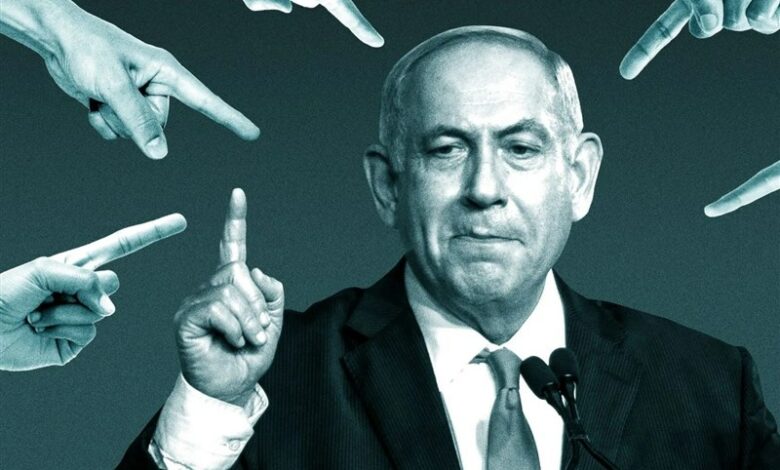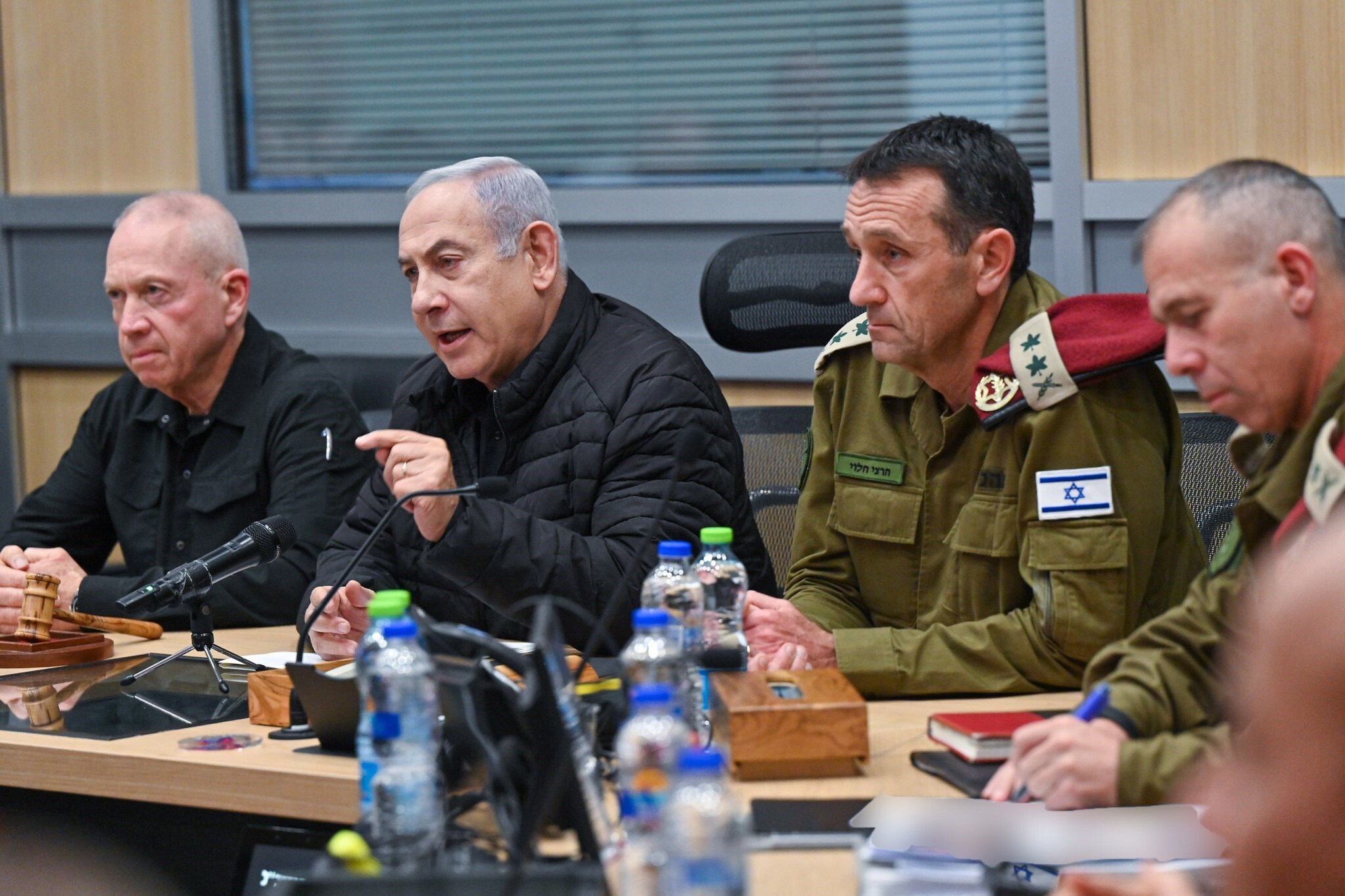The three-faceted crisis of the Zionist regime; Belligerence does not ensure the unity of Israel

| Benjamin Netanyahu's political future has become very unclear while political, social and administrative crises are returning to Israel. |
According to the report of the international group Tasnim news agency, in In the 75 years that have passed since the Zionist regime, the claim of high political, administrative and social cohesion at the time of crisis and war was considered one of the indicators of governance in the occupied territories. However, during the Al-Aqsa storm war and during the past 107 days, developments have taken place both at the political, administrative and social levels, which have put Netanyahu’s emergency and war cabinet in front of difficult choices.
Temporary coherence increase season!
The Battle of al-Aqsa began on the seventh day of October 2023 (15 Mehr 1402), when Israel was involved in a political and social crisis over judicial reforms for more than 10 months. Benjamin Netanyahu’s cabinet, based on the decisive victory he won in the November 2022 elections, put a series of far-reaching reforms on the agenda of his cabinet. p dir=”RTL” style=”text-align:justify”>Street protests against these reforms caused the formation of a severe bipolarity in the social structure as well as official structures and even the army and Mossad. While this bipolarity had reached its peak, the Al-Aqsa storm operation began on the 7th of October. In such a situation, apparently severe political, administrative and social disintegration was temporarily put aside so that the Israeli regime could focus on the war.
Yair Lapid In the first week of the war, the leader of the opposition demanded the formation of an emergency cabinet to manage the war. Contrary to Netanyahu’s expectations, he agreed to this proposal, but when the time came, only Benny Gantz, the leader of the Internal Unity Coalition (who had managed to increase his popularity significantly during the ten-month social protests against the Supreme Court reforms) entered the cabinet with very difficult conditions. . Lapid and Avigdor Lieberman, the leader of our Israel House party, although they initially expressed their desire to join the war cabinet, but in the end they did not agree to join Netanyahu’s war cabinet, and therefore contrary to expectations from the very beginning of the war. Also, the created cohesion remained very minimal.
return of political differences
After more than 100 days of the war, on the one hand, we have witnessed the increase of differences between the two far-right factions and Benny Gantz’s party. We are the axis of the war cabinet, and on the other hand, Netanyahu’s differences with the army and Yoav Galant, the minister of war (with Netanyahu’s party), as well as Gantz, have reached a dangerous level; First, the extreme right wing led by Betsalel Smotrich and Itamar Ben Goyer, who occupy a total of 20% of Netanyahu’s cabinet ministries, are strongly opposed to Gantz’s condition to enter the war cabinet, which limited this cabinet to three members and practically made the security cabinet in The fringes are unhappy.
The extreme right wing of the humanitarian aid arrival with the pressure of the Americans, the seven-day pause in the war and the reduction of the intensity of the conflicts in the phase The third party is unhappy and constantly talks about the need for settlements throughout the Gaza Strip. It seems that the differences of this faction with the process of managing the war in the final phase of the war and when the decisions taken for the future of Gaza, how to return the army forces to the occupied territories and how to manage the Gaza Strip after the war will be determined, and it is even possible. The two parties of Jewish power and religious Zionism should leave the cabinet under the influence of the growing realism of the army chiefs about the end of the war. and army chiefs as well as officials with military experience are being formed; In this regard, the disagreement between the army chief, Hertsi Halevi, with Netanyahu and some of his cabinet ministers regarding the formation of a fact-finding committee to investigate the factors of the military and security failure on October 7th leaked to the media in recent weeks.
The next phase of the disputes within the cabinet 10 days ago by Yaron Avraham, reporter of Channel 12 TV to the media Receipt. In a tweet, Avraham announced the events of the meeting between US Secretary of State Anthony Blinken and members of Israel’s war cabinet. This reporter announced that Netanyahu and Blinken had agreed on the arrival of 150 trucks carrying humanitarian aid to the Gaza Strip, and Blinken thanked the Israeli prime minister and ministers for this during the war cabinet meeting, but to the surprise of the war cabinet ministers. They were unaware of this agreement. Some ministers of Netanyahu’s cabinet criticized this agreement and demanded that it be conditional on the release of all 136 remaining Israeli prisoners. On the other hand, it seems that, under international pressure, Netanyahu accepted that these aids enter Gaza through the port of Ashdod. This is an action completely contrary to Israel’s sanctions policy against the Gaza Strip.
The mentioned events convey the message of the emergence of divisions among the parties of Netanyahu’s cabinet. Of course, the differences are not limited to this level, and new news has also been published in the media, which says that Netanyahu and Gallant have not spoken to each other in recent weeks, and that Netanyahu has tried to sideline the Minister of War and not allow him to meet with the heads of the security agencies. have Also, the media have reported on Netanyahu’s efforts to change the composition of the cabinet. Although Yair Lapid and Avigdor Lieberman, the leaders of the two opposition parties, have many differences with Netanyahu, Bibi asked them to enter the cabinet. This shows that Netanyahu is not satisfied with the current composition of the cabinet and it has become so difficult for him to bear the situation that he is willing to call Lapid to the cabinet.
administrative crisis
Netanyahu’s cabinet from the beginning In 2023, two clauses of the bills related to judicial reforms were approved by the majority of the Knesset and became laws. This had caused the continuation of street protests and the Supreme Court had actually shown its opposition to the mentioned laws in the meeting of the 12th of September, but had not yet taken an official action to cancel them.
With the start of the war on October 7th, it seemed that the judges of the Supreme Court would postpone the final decision on the mentioned laws, but with the beginning of January and the existential risks of the war for Israel, the Supreme Court, which had to announce its opinion Regarding the two laws of reasonableness and dismissal of the prime minister, he was faced with time limits, canceled the law of reasonableness and suspended the implementation of the law of dismissal until further notice. If this event had happened before the war and under normal conditions, the conflicts between the judicial system, the cabinet and the Israeli parliament would have reached a climax and would have put Israel in a “constitutional crisis” situation. In fact, unlike the previous conflicts, the war could not stop the actions of Netanyahu’s opponents. Also, the failure of the cabinet to carry out judicial reforms under normal conditions could lead to the resignation of some members of the cabinet. Israel), Benny Gantz, “src=”https://newsmedia.tasnimnews.com/Tasnim/Uploaded/Image/1402/07/03/14020703192956904284182810.jpg”/>
social crisis
On the other hand, the street protests, which entered their 39th week before the war and were temporarily closed, have started in recent weeks in new forms. A part of the society, in response to the failure of Netanyahu’s cabinet to release the captives, have held several protest marches in the presence of the captives’ families. These protests will probably soon become more widespread and will move towards the demand to end the war and release the prisoners.
by Unlike previous conflicts and wars, protests against Netanyahu’s actions have started again in the streets of different cities in the occupied territories and are increasing. In the last two weeks, protesters have demonstrated several times in Tel Aviv and demanded Netanyahu’s resignation due to the October 7 defeat. In fact, it seems that for Netanyahu, the war is also losing its effect. All three political, administrative and social levels witness the return of the crisis. The big difference between this wave of crisis and the previous events is that, firstly, this three-faceted crisis is placed over the head of the Zionist regime like the sword of Damocles, while the war is still going on, and on the other hand, the crisis in these three levels is condensing and intersecting. which can have dire consequences for Tel Aviv.
end of message/
| Publisher | Tasnim News |



